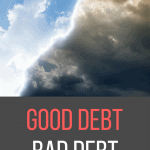THIS POST MAY CONTAIN AFFILIATE LINKS. PLEASE SEE MY DISCLOSURES. FOR MORE INFORMATION.
In today’s financial landscape, debt is often painted with a broad brush of negativity, leaving many to believe that all debt is inherently bad.
However, the truth is more nuanced.
Just as there are good and bad investments, there are also good and bad types of debt.
Understanding the difference between the two can be a game-changer for your financial health.
Good debt can be a powerful tool that helps you build wealth and achieve your financial goals, while bad debt can act as a drain, pulling you further away from your dreams.
But it’s not so cut and dry.
In some cases, good debt can turn bad and bad debt into good.
In this article, we’ll unravel the complexities of good debt vs. bad debt, providing you with the knowledge you need to make smart borrowing decisions and steer your financial future in the right direction.
Keep reading to discover how to harness the power of good debt and avoid the pitfalls of bad debt, setting yourself up for lasting financial success.
KEY POINTS
Understanding Good Debt vs Bad Debt


Debt can act as a tool for personal finance management, but it’s crucial to distinguish between the types that work for you and those that may work against you.
The Concept of Good Debt
Good debt refers to money owed for things that can help build wealth or increase income over time.
This type of debt typically has lower interest rates and is associated with purchasing assets expected to grow in value or generate long-term income.
Here are specific examples of good debt:
- Mortgages: Typically low-interest debt for acquiring real estate that may appreciate.
- Student Loans: Investment in education to potentially increase earning capacity.
- Business Loan: Capital to start or grow your own business, potentially increasing net worth.
The Concept of Bad Debt
Conversely, bad debt involves borrowing money for depreciating assets or expenses that do not provide a return and often come with higher interest rates.
Specifically, bad debt includes:
- Credit Card Debt: Often carries high interest rates and used for consumable goods.
- Auto Loan: Vehicles tend to depreciate quickly once purchased.
- Payday Loans: High interest with short-term relief, potentially leading to a debt trap.
Comparing Good vs Bad
When weighing good vs. bad debt, consider two main aspects: the potential for value increase and the effect on your financial future.
Good debts can potentially improve your financial stability, while bad debts usually do the opposite.
| Good Debt | Bad Debt | |
|---|---|---|
| Potential Growth | Increases net worth or earning potential | Low or no potential to increase in value |
| Interest Rates | Generally lower | Usually higher |
| Financial Outcome | Can lead to wealth-building | Often detrimental to financial health |
Understand the intent and the risk associated with any debt you’re considering.
Good debt can be a strategic investment, whereas bad debt can be a financial burden.
Types of Good Debt
Good debt strategically positions you for financial growth or increased net worth.
It is often seen as an investment in your future, helping you to achieve significant financial goals, such as owning a home or investing in education.
Mortgage Loans
Your mortgage is widely considered good debt.
By financing your home with a mortgage, you invest in real estate that historically appreciates over time.
So, if you took out a $200,000 loan for a $225,000 house in 1990, today that house is worth $350,000.
The debt you took on the house was good debt because the asset (your house) increased in value.
Owning a home offers the potential for capital gain and many tax advantages.
For example, when you sell your home, the IRS allows you to defer tax on a portion of the gain.
Additionally, the interest you pay may be tax deductible.
Student Loans
Investing in your education through student loans can lead to higher earnings potential.
It’s a strategic investment in boosting your qualifications and career opportunities.
You take out student loans to get a better education.
This qualifies you for better jobs, and therefore a higher salary.
Again, the underlying asset (your salary) increases in value.
This is critical as you are your greatest asset, meaning the more you can earn during your working years, the more money you can invest and grow.
One benefit of student loan debt from a tax standpoint is you can deduct the interest you pay.
While this is a nice deduction, you can only deduct a percentage based on your tax rate, not 100% of the interest you pay.
Business Loans
Taking out a business loan can be a lever for wealth creation if you’re starting or expanding a profitable business.
There are many options when it comes to business loans. You could secure one from your local bank, the Small Business Administration, or even friends and family.
If you go the traditional route, you may be able to write off portions of the loan against your income, saving you money.
Types of Bad Debt
Bad debt typically involves borrowing money to purchase depreciating assets or spending on non-essential items that don’t improve your financial position.
Here, you’ll learn about common forms of bad debt, which often carry high interest rates and can lead to challenging financial situations.
High-Interest Credit Cards
Credit cards can be useful financial tools, but high-interest credit cards are a form of bad debt that can quickly become overwhelming.
When you carry a balance on these cards, interest accumulates rapidly, making it difficult to pay down the principal.
Most times, the items you purchase depreciate over time.
In other words, they lose value.
If you use your credit card to buy a new outfit, after you wear it once, you cannot sell it for the price you paid for it.
Payday Loans
Payday loans are short-term, high-cost loans typically intended to be repaid with your next paycheck.
However, the reality of payday loans can lead to a cycle of debt as they come with very high interest rates.
As a result, most people who take out these loans end up falling into a deeper debt trap.
Consumer Loans
Personal and consumer loans for non-essential purchases, such as vacations or luxury items, represent bad debt when they have high interest rates and do not contribute to your net worth.
These loans differ from high-interest credit cards in that they are often installment loans with fixed repayment terms.
But the trouble with them is the same: you cannot get back what you paid for.
The Trouble with Debt


The mistake many people make is not realizing that not all debt that is good is actually good.
For example, let’s look at a small business loan.
On the surface, taking on this debt can seem like a smart move, as building a business can increase one’s wealth.
But if you don’t manage the business right and fail, you have saddled yourself with another debt obligation to repay.
Or consider a mortgage, which going into debt for is seen as acceptable.
But if you buy a house you cannot afford or take on too much debt, you put yourself in financial trouble.
You must recognize the implications of taking on debt, regardless if it is good.
The opposite is true, where typical bad debt could be good, depending on the situation.
Consider personal loans.
If you take one out so you can go on lavish vacations or buy a car, this is not ideal.
However, using personal loans to help you pay off high-interest loans and credit card debt could be a smart use of your money.
You must look at your overall finances and decide whether going into debt is a smart move.
Debt Management Strategies
Effective debt management strategies ensure that you maintain good finances.
By prioritizing high-interest debt and leveraging strategic borrowing, you can efficiently manage debt and reduce interest payments.
Paying Down High-Interest Debt
Your primary focus should be on high interest rates, which significantly increase interest payments.
Use the debt avalanche method, listing your debts from the highest annual percentage rate to the lowest and paying minimums on all but the most expensive debt.
Allocate any excess funds to the debt with the highest interest rate, reducing the overall interest you’ll pay over time.
Alternatively, you can opt for the debt snowball method, which organizes your debts by the amount you owe, from smallest to largest.
You make the minimum monthly payment on all debts except for the smallest.
Then, you pay as much as you can each month to this obligation until it is paid in full before moving to the next smallest one.
Strategic Borrowing
When borrowing, consider the potential return on investment.
Strategic borrowing means choosing debt that will contribute to your financial growth, such as educational loans for skill enhancement or a mortgage that builds equity.
Alternatively, you can take out debt with a lower interest rate to help pay off higher-interest debt.
I’ve used this strategy multiple times.
For example, when I was in credit card debt, I had a card on which I paid 17% interest.
I transferred a balance to a credit card with a 0% offer for 12 months.
I transferred $5,000 over to the 0% offer and paid roughly $417 a month to make sure that the balance was gone when the promotional rate ended.
Impact of Debt on Financial Health
When you borrow money, the structure of the debt and how you manage it can have significant consequences on your financial health.
Important aspects to consider are your debt-to-income ratio and credit score implications.
Debt to Income Ratio
Your debt-to-income ratio (DTI) is calculated by dividing your total monthly debt payments by your gross monthly income. A lower DTI demonstrates a balance between debt and income, which is essential for financial stability. For example:
- Gross Monthly Income: $5,000
- Total Monthly Debt Payments: $1,500
- Debt to Income Ratio: $1,500 / $5,000 = 0.30 or 30%
A DTI of 30% or lower is typically considered satisfactory, indicating that you are not overly burdened by debt. Still, you should know the warning signs you have too much debt.
Credit Score Implications
Your credit score reflects your creditworthiness and is vital to your financial health.
Actions such as consistently making on-time monthly payments can lead to a good credit score, whereas missing payments or using a high percentage of your credit limit can harm it.
Remember that on-time payments can improve your score.
Avoiding Debt Traps
In managing debt, navigating away from potential traps that can exacerbate financial strain is crucial.
This means exercising vigilance towards high-risk products, maintaining a disciplined spending approach, and building a solid financial foundation capable of absorbing shocks.
Recognizing Risky Financial Products
Identify financial products that could lead to unsustainable debt.
Payday and high-interest loans are notorious for their steep interest rates and fees.
They may seem like quick fixes, but often, they lead to a cycle of debt that’s hard to break.
Lifestyle and Spending Habits
Your day-to-day choices significantly impact your financial health. Aim to:
- Live within your means and avoid debt where possible.
- Categorize your spending and identify areas where you can save money.
- Tackle credit card balances quickly to prevent snowballing interest.
Frequently Asked Questions


Understanding the differences between good and bad debt can influence your financial strategy and help you make informed decisions.
What are the characteristics that classify debt as good?
Good debt serves as an investment for your financial future, potentially leading to increased net worth or income over time.
For instance, a home mortgage can appreciate in value, or a student loan can result in higher earning potential.
In what scenarios might good debt become detrimental to financial health?
Good debt can become burdensome if you take on more than you can afford or if the investment depreciates.
A mortgage, for example, can be a liability if the housing market drops significantly or employment is lost, making payments unsustainable.
Additionally, buying too big of a house makes you house-rich and cash-poor with payments you cannot afford.
What types of debt are typically considered bad and why?
High-interest consumer debt, such as credit card balances or payday loans, is considered bad debt as it typically finances depreciating assets or consumable goods and does not contribute to financial growth.
Their high cost can also erode your wealth over time.
How does one effectively manage debt to maintain its good status?
To manage debt effectively, regularly assess your financial situation to ensure you can make payments without strain.
Avoid accruing unnecessary high-interest debt and prioritize repayment strategies that target high-interest debts first.
I have over 15 years experience in the financial services industry and 20 years investing in the stock market. I have both my undergrad and graduate degrees in Finance, and am FINRA Series 65 licensed and have a Certificate in Financial Planning.
Visit my About Me page to learn more about me and why I am your trusted personal finance expert.




